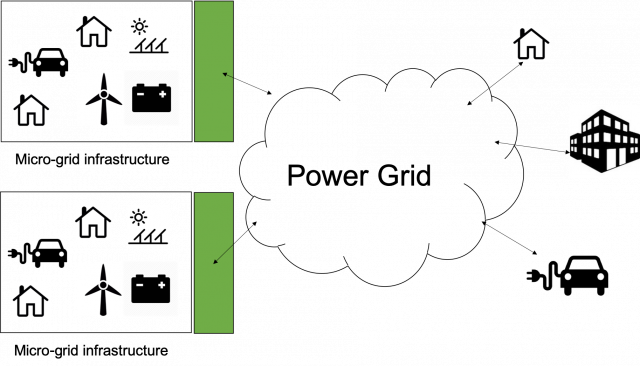Why is energy such a hot topic?
The issues of energy provision and management have been at the forefront of discussions both in domestic and business settings over the last couple of years. Conflicts that impact supply coupled with increasing concern about our rapidly warming planet have made us all much more aware of how we use and source our energy. It seems, therefore, like a great idea to switch to renewable, decentralized energy sources, doesn’t it? But have you thought about how these energy supplies will be managed? The complex distribution system that ensures the lights go on when we flick the switch has been in place for decades and we need to turn it all on its head to make sure renewably-sourced energy hits our households and businesses with the same efficiency.
Traditional power grids date back to when Thomas Edison was a young man and are designed to supply electricity at constant voltages, driven by fossil fuel supplies. We have had a long time to perfect the generation, transmission and distribution of electricity in this way, but now solar, wind and other renewable energy sources with their decentralized production are shaking up the model. Unless you live in the Truman Show, wind and sunlight are much more difficult to predict, which means forecasting and managing supply and demand is more challenging. On top of that, people are not only consuming electricity in different ways, with, for example, the increased usage of electric vehicles, but also potentially putting energy back into the grid via solar panels. All of this can affect the stability of power grids and mess with the way stakeholders in the system are funded. So how can we transition to cleaner energy while still ensuring that the grid infrastructure is stable, properly maintained and funded?
What do we need for a smarter grid?
Many elements are required to make this work, including updates to policy and regulatory frameworks, public awareness campaigns, consumer incentives and of course cutting-edge technologies. All stakeholders in the energy market will have to embrace innovative solutions to deliver the dynamic market needed to address these challenges. Decentralized microgrids, where a group of interconnected buildings form their own local energy system, will certainly play a part. Efficient microgrids will rely heavily on the latest technologies such as the Internet of Things, Artificial Intelligence and cloud and edge computing. Moreover , the liberalization of the electrical energy market will certainly lead to the emergence of new digital services in the energy sector. These services will mainly rely on the electrical energy consumption/production forecast. And here is where SWARM comes in.
The work of the SWARM project
The members of the SWARM consortium are focusing on the technological challenges of the above problem. The project is building a digital platform based on a “Smart Energy Management Appliance” (SEMA) which can be deployed on microgrid infrastructures. The plan is to provide new services which will allow users to become active participants, thus becoming direct beneficiaries of a liberalized energy market. The SEMA will provide not only supply and usage predictions, but also the ability to trade energy and flexibility. The project is supported by experts in the fields of energy and digitalization.
Reimagining the grid

SWARM Partners
HEPIA Haute école du paysage, d’ingénierie et d’architecture is one of the 6 schools of the HES-SO Geneva campus. With its four research institutes, HEPIA forms a centre of excellence in engineering and architecture. Its expertise in the domain of edge-cloud solutions and self-adaptive IoT applications is critical to the SWARM project.
CLEMAP pursues the vision of a world where people, devices, buildings and industries understand their energy flows and work towards sustainable energy use. As a technology partner, the company offers solutions to system integrators, electrical installers, and industrial consumers when it comes to using energy efficiently in the market of Smart Grid, Smart Building
Groupe E SA is a leading Energy Company operating in western Switzerland. As a Grid Distribution Operator, it delivers electrical energy to over 400’000 private citizens and numerous professional customers in its service area. As grid operator, Groupe E provides the business view of its industry, helping with providing data and suggesting applications for deployment .
Recap Power started in 2018 under the name Tvinn, with a vision to create solutions that contribute to a more sustainable future. Recap Power offers aggregator services, solve capacity problems and offer smart management of batteries, electric vehicle chargers and local energy production, as a service! KTH Royal Institute of Technology is an international technical university, spanning from natural sciences to all the branches of engineering.
The Geneva communes of Meyrin and Chêne-Bougeries act as microgrid infrastructure providers, working in close collaboration with the project.
SWARM is a Eureka Eurostars project, co-funded by the Innosuisse Swiss Innovation Agency and the European Union.
Learn more
lsds.hesge.ch/smart-and-widely-distributed-appliances-for-renewable-energy-management


